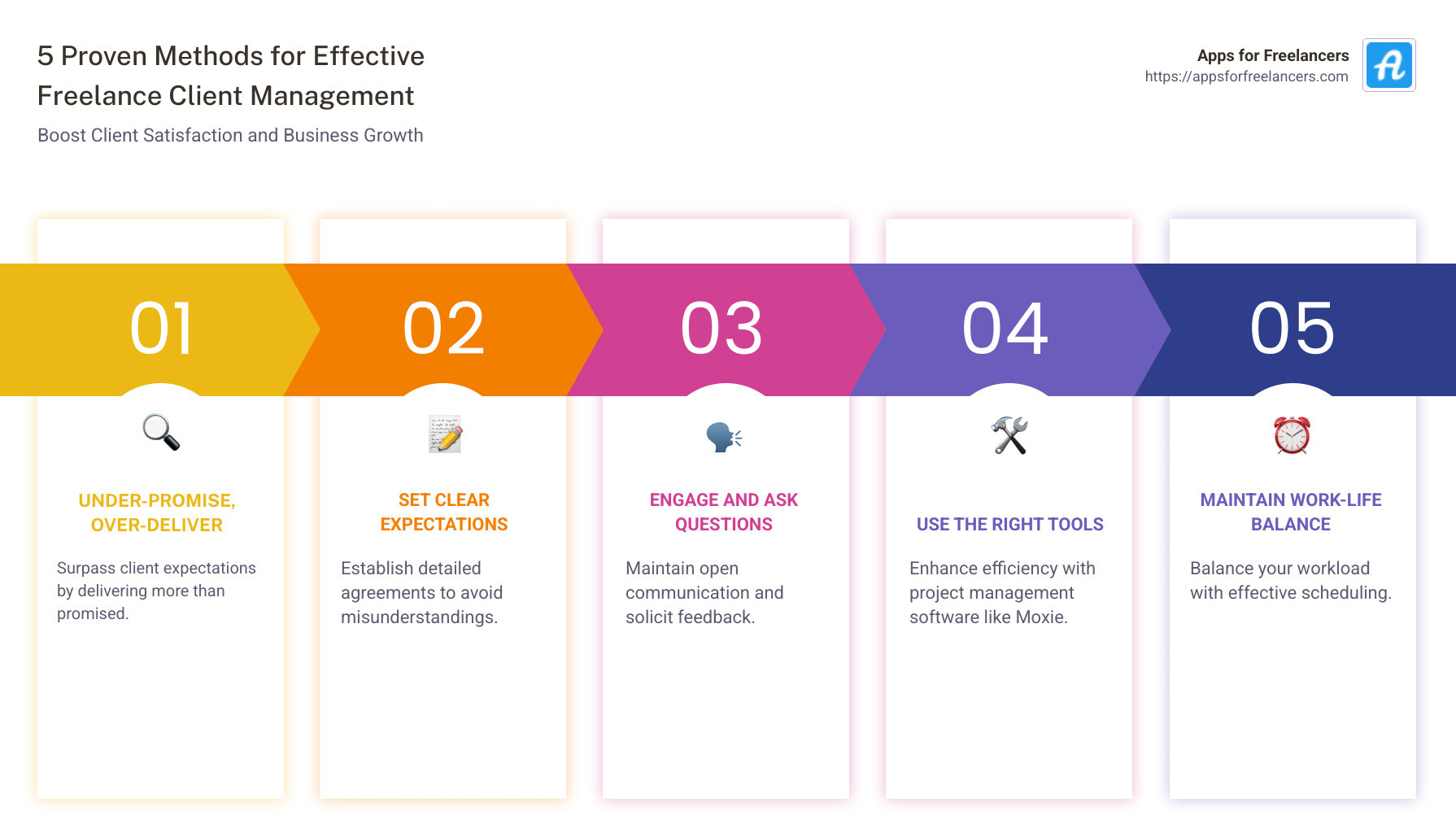
How to Manage Freelance Clients: 5 Methods that Guarantee Results
Freelance client management is the backbone of successful freelancing. Whether you’re a seasoned freelancer or just starting out, managing client relationships effectively can skyrocket your business growth. Here’s how to quickly tackle freelance client management:
- Under-Promise, Over-Deliver: Surprise clients with more value than promised.
- Set Clear Expectations: Prevent misunderstandings with detailed agreements.
- Engage and Ask Questions: Foster smooth communication and encourage feedback.
- Use the Right Tools: Leverage technology like Moxie for project management.
- Maintain Work-Life Balance: Prioritize effective scheduling to balance workload.
These methods not only improve client satisfaction but also ensure your freelance business flourishes in the long run.
Freelancing means more than just completing projects—it’s about cultivating lasting client partnerships. By embracing these strategies, you’re not just a service provider but a trusted partner in your client’s success.

Understanding Freelance Client Management
Freelance client management is all about building and maintaining strong relationships with your clients. It’s the art of balancing client expectations, delivering quality work, and ensuring effective communication. As a freelancer, mastering client management can set you apart and lead to long-term success.
Key Aspects of Client Management
-
Setting Expectations:
- Start by clearly defining the project scope and deliverables.
- Establish timelines and deadlines to keep everyone on track.
- Discuss pricing and payment terms upfront to avoid surprises later.
-
Communication Methods:
- Active Listening: Pay attention to what the client needs and wants. It helps in tailoring your services to meet their expectations.
- Clear Language: Use simple and straightforward language. Avoid jargon that might confuse clients.
- Regular Updates: Keep clients informed about project progress. This builds trust and reduces anxiety about the project’s outcome.
-
Feedback and Revisions:
- Set a clear process for feedback and revisions. Define how many rounds of revisions are included and how feedback should be given.
- Be open to feedback and ready to make necessary changes promptly.
-
Using Technology:
- Leverage tools like Moxie to manage projects and client communications efficiently. These tools can help you keep track of tasks, deadlines, and client interactions in one place.
-
Building Long-Term Relationships:
- Aim to be more than just a service provider. Position yourself as a partner in your client’s success.
- Regular check-ins and follow-ups can strengthen the relationship and lead to more work opportunities.
By focusing on these elements of freelance client management, you can improve your reputation, secure repeat business, and enjoy a more rewarding freelance career.
In the next section, we’ll dig into five proven methods for effective freelance client management, ensuring you deliver exceptional value to your clients.
5 Proven Methods for Effective Freelance Client Management
1: Under-Promise and Over-Deliver
Setting realistic expectations from the start is crucial. When you promise less and deliver more, you not only meet client expectations but exceed them. This approach builds trust and showcases your professionalism.
Example: If a client asks for a 1500-word article in two days, agree to the timeline but aim to deliver within 24 hours. This surprise element can turn one-time clients into regulars.
2: Set Clear Expectations
Clear expectations are the backbone of any successful project. Begin by defining the project scope and deliverables. This prevents scope creep, where projects expand beyond their original boundaries.
Contract Agreements: Always have a written agreement outlining the project details, timelines, and payment terms. This protects both you and the client from misunderstandings.
3: Engage and Ask Questions
Communication is key. Don’t hesitate to ask questions if something isn’t clear. Engaging with clients shows your commitment to delivering exactly what they need.
Feedback: Encourage clients to provide feedback. It helps you refine your work and ensures client satisfaction. Asking questions doesn’t show weakness; it shows dedication.
4: Use the Right Tools
Technology can be your best friend in managing freelance clients. Tools like Moxie offer project management features that streamline your workflow.
Project Management Software: These platforms help you keep track of tasks, deadlines, and communications. They ensure nothing falls through the cracks and allow you to focus on delivering quality work.
5: Maintain a Balanced Workload
Balancing work and life is essential for long-term success. Overloading yourself can lead to burnout and decreased productivity.
Scheduling: Use scheduling tools to allocate time for work, rest, and personal activities. This balance not only improves your productivity but also keeps you motivated and happy in your freelance career.
By implementing these five methods, you can master the art of freelance client management. This will not only improve your client relationships but also boost your professional growth and satisfaction.
In the next section, we’ll address some frequently asked questions about freelance client management to further improve your understanding.
Frequently Asked Questions about Freelance Client Management
What does a client management do?
Client management involves coordinating sales and ensuring structured interactions with your clients. It’s about keeping the communication lines open and clear, making sure everyone knows what to expect. This includes setting up initial meetings to discuss project requirements and maintaining regular check-ins to track progress. By doing so, you build trust and create a positive working relationship.
How do you charge freelance clients?
Charging clients can be tricky, but understanding different pricing models can help.
- Hourly Pricing: This is straightforward. Charge based on the hours you work. It’s ideal for projects with uncertain scopes where tasks might evolve over time.
- Rate Setting: When setting your rates, consider your experience, the complexity of the project, and industry standards. This helps ensure you’re fairly compensated for your work.
How to manage multiple clients as a freelancer?
Managing multiple clients requires transparency and the use of effective management tools. Being transparent means keeping clients informed about your workload and potential timelines. It helps manage their expectations and prevents misunderstandings.
- Management Tools: Use project management software to organize tasks and deadlines. These tools help you track your progress and ensure that you meet all client requirements without overloading yourself. They also allow you to maintain a balanced workflow, keeping your work stress-free and efficient.
By addressing these key areas, you can improve your freelance client management skills and ensure a smoother, more productive freelance career.
In the conclusion, we’ll explore how Apps for Freelancers can further aid in boosting your productivity and client satisfaction.
Conclusion
As freelancers, managing client relationships effectively is key to our success. This is where freelance client management becomes crucial, and having the right tools can make all the difference. At Apps for Freelancers, we offer a curated selection of productivity tools designed to streamline your workflow, improve your project management, and improve your client interactions.
By integrating these tools into your daily routine, you can ensure that you’re not just meeting client expectations but exceeding them. This boosts client satisfaction and opens the door to more opportunities, referrals, and long-term partnerships.
Our platform focuses on providing resources that help you manage your projects, finances, and client relationships with ease. Whether it’s tracking your time, sending invoices, or organizing tasks, the right tools can transform how you work. By reducing the mundane, you free up more time to focus on what truly matters—delivering top-notch work and growing your freelance business.
In conclusion, embracing the right productivity tools is not just an option; it’s a necessity in the evolving freelance landscape. With Apps for Freelancers by your side, you can steer the challenges of freelance client management with confidence and watch your business thrive.